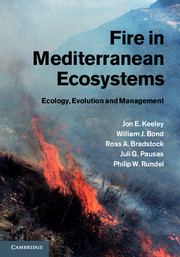Book contents
- Frontmatter
- Contents
- Section I Introduction
- Section II Regional patterns
- Section III Comparative Ecology, Evolution and Management
- 9 Fire-adaptive Trait Evolution
- 10 Fire and the Origins of Mediterranean-type Vegetation
- 11 Plant Diversity and Fire
- 12 Alien Species and Fire
- 13 Fire Management of Mediterranean Landscapes
- 14 Climate, Fire and Geology in the Convergence of Mediterranean-type Climate Ecosystems
- References
- Index
9 - Fire-adaptive Trait Evolution
from Section III - Comparative Ecology, Evolution and Management
Published online by Cambridge University Press: 05 January 2012
- Frontmatter
- Contents
- Section I Introduction
- Section II Regional patterns
- Section III Comparative Ecology, Evolution and Management
- 9 Fire-adaptive Trait Evolution
- 10 Fire and the Origins of Mediterranean-type Vegetation
- 11 Plant Diversity and Fire
- 12 Alien Species and Fire
- 13 Fire Management of Mediterranean Landscapes
- 14 Climate, Fire and Geology in the Convergence of Mediterranean-type Climate Ecosystems
- References
- Index
Summary
Until relatively recently the importance of fire and the origin of fire-adaptive traits have received minimal attention from paleoecologists, and appreciation of this importance has varied across the different mediterranean-type climate (MTC) ecosystems. For example, Axelrod (1973) and Raven & Axelrod (1978) wrote extensive treatises on the origins of the California flora, and yet gave little or no mention to the issue of fire in the evolution of these taxa. Hopper (2009) suggests that fire has only been an incidental factor in the evolution of the Western Australian flora. These investigators have weighed climate and soils far above fire as an important evolutionary driver in these plant assemblages and have downplayed this component of community assembly (see Fig. 1.4).
Axelrod (1989) even went so far as to suggest fire was irrelevant to the evolution of California chaparral. Although he acknowledged that fire could have played a role in the spread of chaparral-like vegetation during the late Tertiary (2–10 Ma), he insisted that fire had played no significant role in the origin of “adaptive types.” In his view, “Several lines of evidence suggest that the modern fire-adapted taxa may not reflect an evolutionary response to fire. The diverse adaptations to fire probably represent features that originated without the stimulus of fire. . .” Contrary to this belief, we suggest there is sufficient reason to accept a fire origin for many fire-adaptive traits in mediterranean-type vegetation (MTV), and that fire has been a potential ecosystem process on landscapes far longer than the late Tertiary (Bowman et al. 2009; Pausas & Keeley 2009).
- Type
- Chapter
- Information
- Fire in Mediterranean EcosystemsEcology, Evolution and Management, pp. 233 - 274Publisher: Cambridge University PressPrint publication year: 2011

